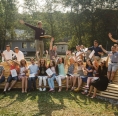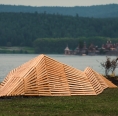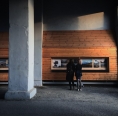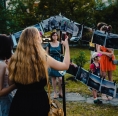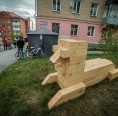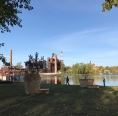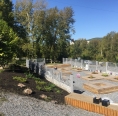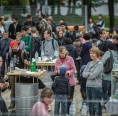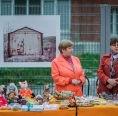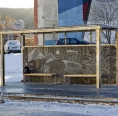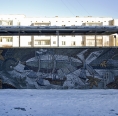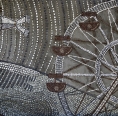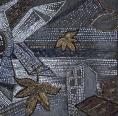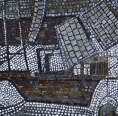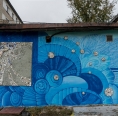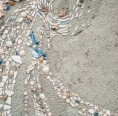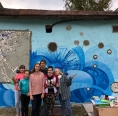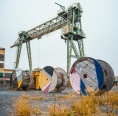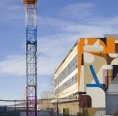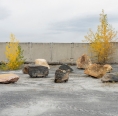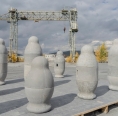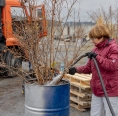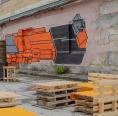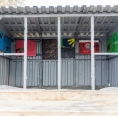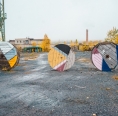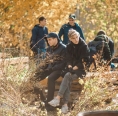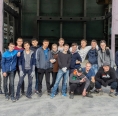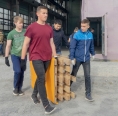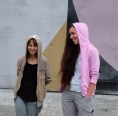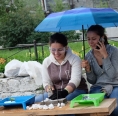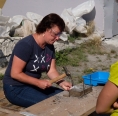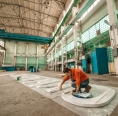-
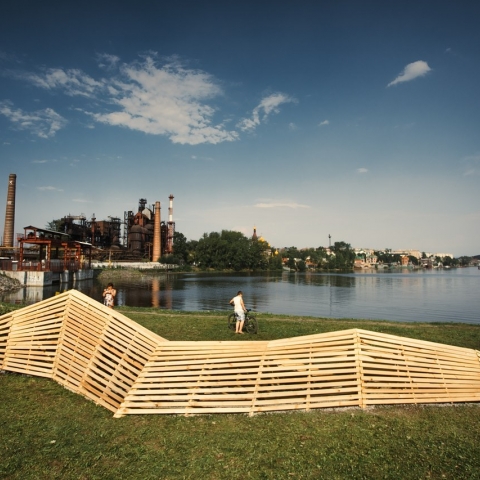
My Satka
Architectural Festival
The Annual International Festival which was already held in Satka three times: from July 24 to August 2 in 2016, from May 21 to 27 and September 7-14 in 2017, and from August 10 to November 9, 2018.
The project has the form of training seminar where team of volunteers and experts create urban amenities.
Groups of volunteers led by professional architects and urbanists develop and build functional amenities to improve urban environment.
The project that won the 2018 «Champions of Good Deeds-2017» competition in the Local Communities nomination.
In 2018, project «My Satka» won the first competition of the Presidential Grant Fund.
"My Satka" festival wins the contest of corporate volunteer projects
2016
An architectural festival was held in Satka from July 24 to August 2. The festival was organized with the support of Sobranie Fund and Marsh Lab architectural bureau in the form of the My Satka workshop. During 10 days, four teams of architects from various cities of Russia (St. Petersburg, Ivanovo, Ufa, Moscow) and 70 volunteers from Satka designed four wooden architectural objects which were installed in various parts of the city.
The team of Aleksey Melnikov from Ufa presented a large wave-like bench named Ural Mountain which was placed on the bank of the pond in the old part of the city and is intended to become the most photographed in the city. The team of Mikhail Shatrov implemented a multifunctional arbor Yard which “restarted” life in the yard between houses No. 14 and No. 20 on Industrial Street. In the arbor, one can play board games or make barbecue. The arbor also has various non-standard entertainments for children. The Arc facility (19th quarter) made by the team of Natalia Parsadanova (St. Petersburg) is the gallery in a residential house arc which will now become the exhibition space for local amateur photographers club. A grandiose amphitheater was made under the guidance of Alexandra Chertkova (Moscow) near Magnezit Culture Center. Now, one can meet sunsets here and admire the rock garden stretched out before the amphitheater. City residents of all generations took active part in transformation of city streets under the guidance of architects and designers.
It should be noted that each facility created in the workshop was beautified with urban gardening under the guidance of dendrologist Igor Safiullin, and only ecologically clean and natural materials were used upon creation of the expositions. Tutors and participants tried to bring missing, in their opinion, elements in usual city space of Satka, conforming them with residents’ desire. All facilities created are functional and interact with peoples.
– We are witnessing a worthy event for Satka, – head of the Satkinsky Municipal District Alexander Glazkov said during the ceremony of opening of facilities created during the festival. – If there is a desire, a lot can be done for the city even in 10 days, and the most important thing that young guys joined the process. I hope that the facilities created will become favorite recreation areas for residents and guests of Satka. I genuinely want this event to become the beginning of long creative collaboration in which we will create a lot of facilities popular among Satka residents.
It should be noted that after the workshop the facilities created are transferred to the city, and the providers hope that local residents will preserve and augment all that was done in the 10 days.
2017
Another season of the architectural festival had come to an end in Satka. Both foreign experts and volunteers who care about the city’s look took part in the festival. They joined their forces and added some interesting facilities to the city over the past few months.
Large-scale changes began this year since May 21. Providers of My Satka Festival invited architects, designers and street artists from Russia, Italy and Switzerland. A lot had to be done this season: putting to rights the things that were created a year ago and implementing fresh ideas. Festival curator Egor Larichev does not conceal: participants ventured to tackle more large-scale projects, and it was a right decision.
Now, all or almost all festival participants have photos with sphinxes. The wooden figures on the festival sites symbolize coming changes which will affect the city environment of Satka.
A concrete dolmen appeared on the city pond embankment: Swiss designer Dimitri Bähler, with the help of volunteers, decorated the wall with dolomite and magnesite mosaic. The wall subsequently transformed into an unusual public transport stop. Mosaic technique was also used in another stop of the city. Its sketch was offered by Moscow artist Maria Volokhonskaya.
Then man-size vases were installed on the embankment. The authors – Swiss designers Adrienne Rovero and Christoff Fuad – designed the vases to resemble blast furnaces. Due to CEO of the botanic garden of the Chelyabinsk State University Vera Merker, the giant flower pots received “inhabitants” – trees which are highly adaptive to the Ural climate.
So-called "Ruina" – an abandoned place near Magnezit Cultural Center left after demolished residential house – became another festival site. Moscow architect Igor Aparin from Kontora bureau tackled the Ruina. Wooden pallets, wire mesh and large-fraction rock – and the site becomes a place for mass city events. The Ruina can be easily transformed depending on the format of events. Neighbour’s Fair and the photo exhibition of the Swiss architect and photographer An-Lor Le Sha were already held here. The Ruina also hosted the Fantasy street art exhibition. To surprise of the audience, works of fifty modern artists were exhibited open air.
This year, My Satka Festival was coordinated by Sobranie Cultural Initiative Supporting & Preservation Fund, the municipal government, Pro Helvetia, the Swiss Arts Council, and the Istituto Italiano di Cultura in Moscow. However, an event of such level would be impossible without contribution of dozens of volunteers and their teachers. Together, they proved that everyone can change ambient space for the better. That means than My Satka Festival will certainly return in 2018.
2018
In August-September-October the town hosted "My Satka" festival of urban development which participants included artists, designers and architects from Moscow, Krasnoyarsk, Ekaterinburg and Chelyabinsk as well as foreign guests actively supported by the town volunteers.
More than twenty-day marathon on creation of two side monumental decoration of the public taxi bus stop in Zapadny microdistrict held by Moscow muralists Maria Volokhonskaya and Maria Laricheva was accompanied by activities of Street Mosaic School − open lessons, work with the material, open-air practice.
It resulted in two mosaic boards of the total area of 25 square metres devoted to the metaphysics of spatial movement. The mosaics are made from the minerals found in Satka region: apart from magnesite and dolomite usual and well-known to Satka people by industrial sites and dumps, siderite, brucite, iron clay and even exotic bauxite − the source of aluminium and rare metals − are found here.
The taxi bus stop project is developed by Moscow architect Dmitry Baryudin, already known to Satka people by the architecture of "Magnezit" museum, wooden sphinxes decorating the banks of the town pond and Ruina square enclosed with mesh walls.
Another monumental object − mosaics of Aleksandra Spiridonova, a graduating student of Stroganov Academy − was carried over with the help of volunteers to the wall of a transformer vault in the centre of Satka. The brilliant general formula of the decoration allowed the volunteers to make their own creative contribution.
At the end of October 2018, a sculpture made by Alexey Luchko, known in the street art world as Luka, appeared near the lower gate of Magnezit Group industrial site leading to the former BelAZ repair shop. The combination of the textures of the seven-metre architecton made of two cubes placed one on another reminds Satka people about the stalls used to be a part of urban landscape not long ago.
Luka's piece of architecture will mark the entrance to the territory which starting from this year will become a driver of urban changes in Satka. Famous BelAZ repair Hangar already valued by the town people on the Steel Worker Day and the surrounding area will become a place of cultural activities of the town and Magnezit Group starting from the beginning of summer.
To examine the potential of the site and sum up all ideas of the last years on its development, "Hangar 18" project workshop was organized in the beginning of August which gathered architects Dmitry Baryudin, Mikhail Labazov and curator of the festival architectural part Egor Larichev, the writer of these words.
In addition to the area development concept for the next year, an action plan on ‘shock’ humanization of the area in the scope of the festival 2018 was prepared. The façade of the large Hangar building was decorated by Luka’s graphic art, the lighting tower − with abstract pattern of Zedz, a Dutch artist, whose robots also decorated the side face of the hangar. Colour cable reels appeared in the surrounding area. During already traditional Pere-satka campaign, a group of dendrologists of the Chelyabinsk State University headed by Vera Viktorovna Merker and Satka volunteers tubbed the plants to be used for ‘green navigation’ in the area surrounding the Hangar. Oxygen Cabin appeared in front of the Hangar. It is a small gallery of street art with step amphitheatre made by Denis Ilbeykin, a wood craftsman from Sovetskaya Gavan town. The first exhibition was the personal show of Vasya Suslov, an eight-year old Satka artist inspired by German street artist Hendrik.
"Two Spirits" sculptural group by Swiss sculptor Florian Graf, the participant of the 4th Industrial Biennale in Ekaterinburg, manufactured from refractory concrete by the Department of Innovative Products of Magnezit Group, made as anthropomorphous columns resembling a matrioshka doll and installed in the framework of the festival, were silently but as if sympathetically watching the collective efforts of the festival participants on rearrangement of the area near the Hangar. Silent stones of the garden also arranged here seemed to be waiting for their turn to talk to Satka people. Tables and chairs from pallets, "U Robota" open bar, a large bench near the Hangar entrance completed the picture of instantaneous landscaping full of spontaneity, hedonism and belief in the possibility of changes.
The final of the festival turned to be symbolical: Alexsandr Zakirov, an abstract artist from Krasnoyarsk, installed, with physical support of the festival curator, letters "My Satka" on a travelling bridge inside the Hangar. So, the fact was symbolically established: now Satka festival has its home and, to be precise, not just a home, but an entire Hangar. As for the exact meaning of the symbol, we will know it soon. ‘The experience of spontaneous humanization of a post industrial area’ turned to be exceptionally productive. Thanks to all of you!
This year, the festival was held under the support of Satka Municipal Administration, "Sobranie" Cultural Initiative Supporting & Preservation Fund and the President Grants Fund.
Egor Larichev
2024
My Satka, an international social and cultural project of the city and territory development, which is implemented by the Sobranie Fund with the support from Magnezit Group, won a prize in the program called “Best Social Projects in Russia” in the category “Culture, Arts and Religion”. The awarding ceremony was conducted in Radisson Resort Hotel (Zavidovo) in the end of the last week.
My Satka is a creative project, which was launched in summer 2016 and then became a long-term one. It aims to overcome the isolation of the mono-city, improve the city environment, as well as to promote cultural initiatives as an instrument to develop the territory, which is used by Magnezit Group to pursue their activities. The project events are organized in the form of international festivals in two spheres: Art-Satka (modernization of large urban landscape objects and decorating of facades) and Arch-Satka (creation of small architectural objects, which are integrated into the public spaces of the city).
Experts of the “Best Social Projects in Russia” competition appreciated the festival for the innovative approach to the spatial transformations and the new actual mechanisms involved for the local communities to study the pieces of architecture, fine arts and urban solutions, which are now actively introduced in the urban development practice. Prominence was also given to the diversity of events united by My Satka. These are leisure and educational activities, organization of creative spaces and creation of trendy urban design objects involving famous national and foreign artists, who make art-installations, murals, sculptures and urban infrastructure elements, who give master-classes for local residents and engage them into co-creation. As a result, city residents actively participate in the implementation of the artists’ ideas, when the latter make small architectural objects.
Thus, My Satka not only forms the new urban cultural landscape, but also contributes to the active development of the local creative initiatives, to the formation of communities and sustainable collaboration systems, which wish to make the city a better and more interesting place.
This project is one of the social programs started by Magnezit Group and implemented within the sustainable development and social investment policy.
OUR INFO:
The program called “Best Social Projects in Russia” is an annual socially beneficial award that has been granted to the leaders in the field of corporate social responsibility since 2012.
The mission of the competition is to unite, inspire and support state, business and funds, which put into action the initiatives to solve social problems and to contribute to the development of a favorable social medium.
-
2025
Lecture series on art
-
2012
The Russian Museum. Satka
-
2019
MAMM

